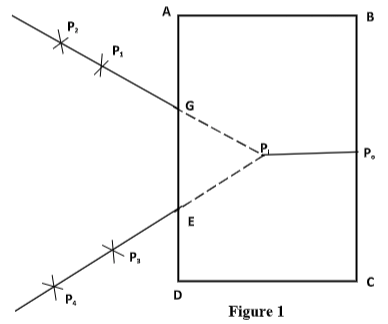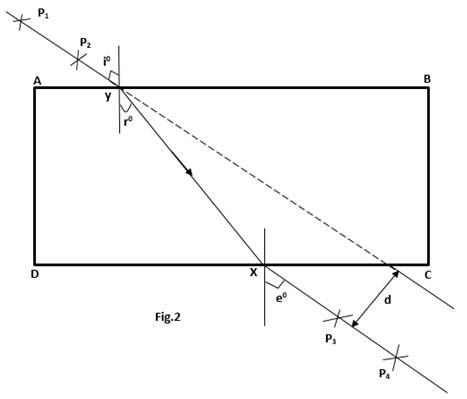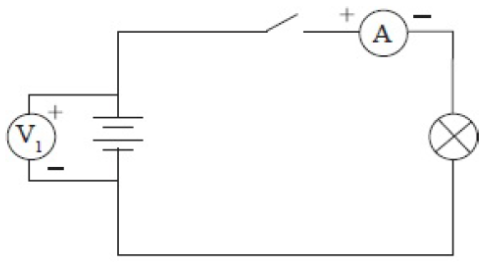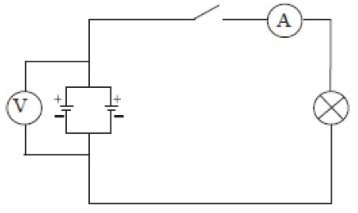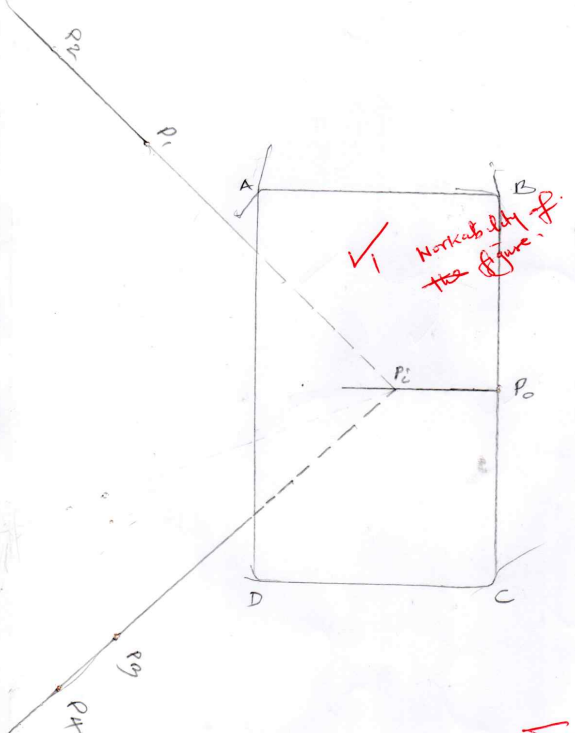QUESTIONS
Question 1
You are provided with the following apparatus:
- Rectangular glass block
- Two plain papers
- Four optical pins
- Four paper pins or thumb pins
- Protractor
- Half meter rule
PART A
PROCEDURE:
- Place the glass block on the plain paper on its largest area, trace it’s outline and mark it’s sides ABC and D. Mark the point P0 on the center of side BC as shown in Figure 1 below.
- Measure the breadth of the glass block.
b =….……..cm (1 mark) - Replace the glass block and fix an object pin at P0 such that the pin lies along the surface of the glass block.
- With your eye on the side AD closer to A, fix pins P1 and P2 such that they are in line with the image Pi of P0 as seen from the side AD through the glass block.
- From the same side AD closer to D, fix pins P3 and P4 such that they are in line with the image Pi of P0 seen through the glass block.
- Remove the glass block and join P1 and P2, and P3 and P4 to meet at Pi.
- Join P0 to Pi and measure length P0Pi
P0Pi =…………………………………..m (1 mark) - Determine the ratio; b = n (2 marks)
b − P0Pi
(Hand in the outline with the question paper.) (1 mark)
PART B
- Trace the outline of the glass block again on the second plain paper and label it ABCD as shown in Figure 2.
- Construct a normal on the side AB approximately 3cm from A and measure angle of incidence i =35° (secure the plain paper using paper pins).
- Replace the glass block on the outline and fix pins P1 and P2 along the line of 35°.
- Viewing from the sides CD through the block, fix pins P3 and P4 such that they appear in line with the images of P1 and P2.
- Join P3 and P4 and join x and y.
- Extend the line P1 and P2 to obtain lateral displacement as shown in the figure and measure the lateral displacement d and angle r0.
- Tabulate your results.
- Repeat the procedure in (i) to (vi) for angles of incidence 45°, 55°,65° and 75°.
(Hand in the plain paper on which you have done your experiment together with the exam paper) (2 marks)
(5 marks)i0 35 45 55 65 75 r0 d(cm) - Plot a graph of d(cm) against r0 (5 marks)
- From your graph:
- Determine the value r0 where the lateral displacement d equals to the breadth b of the block.
r0 = ……………………………………………………… (1 mark) - Given that k sin r0 = 1, determine the value of k (2 marks)
- Determine the value r0 where the lateral displacement d equals to the breadth b of the block.
Question 2
PART A
- A glass beaker
- A metal solid
- Some water
- Source of Heat
- A piece of cotton thread
- A plastic beaker wrapped with tissue paper on the outside.
- A thermometer
- Liquid L
- Measuring balance to be shared
Proceed as follows:
- Fill the glass beaker with the water provided and place it on the heat source.
Use the piece of thread to carefully lower the metal solid to the bottom of the beaker. Heat the water to its boiling point. Use the thermometer to measure its point.
Boiling point of water =………………………………Kelvin (1 mark) - Find the following measurements using appropriate instruments
Mass of the metal solid Ms = …………………………… g (½ mark)
Mass of the wrapped empty plastic beaker
M1………………………………g (1 mark)
Use the plastic beaker to measure 240ml of liquid L, hence find the joint mass of the plastic beaker and its content liquid L,
M2 =……………………………………………. g (½ mark)
Initial temperature of liquid L, T1 = …………………………………..Kelvin (1 mark) - At boiling point of water, quickly transfer the metal solid into liquid L, stir well and measure the temperature of the mixture immediately.
Temperature of the mixture
T2 = …………………………………. Kelvin (1 mark) - By using the measurements taken in parts (a), (b) and (c) as well as the equation provided below, determine the specific heat capacity of liquid L.
(Take S.H.C. of metal solid = 480Jkg-1k-1 and S.H.C. of plastic = 359 Jkg-1k-1)
(Heat lost by metal solid) = (heat gained by liquid L) + (heat gained by plastic beaker) (3 marks)
PART B
You are provided with the following apparatus:
- A nichrome wire
- A 20g mass
- A meter rule
- A test –tube
- A retort stand, boss, and clamp
Proceed as follows:
- Measure the length, L, of the nichrome wire provided
L = ………………………. cm (½ mark) - Wind the whole length of the wire tightly on the test-tube making sure that the turns are as close as possible but not overlapping. Measure the length, β, of the coil made.
β =………………………………. cm (½ mark) - Remove the coil from the test-tube. Straighten the first and the last turns of coil. Bend one end to make a hook.
- Count and record the number, N, of complete turns remaining on the coil.
N =……………… (1 mark) - Measure and record the distance h1 between the end turns of the coil as shown on the Figure 1 below.
h1= ……………………………………. (½ mark) - Load a 20 g mass on the coil as shown in Figure 2 above. Measure and record the distance, h2, between the end turns of the coil.
h2 = ……………………………………. (½ mark) - Determine the spring constant K in S.I units. (1 mark)
- Obtain the constant, P, for the wire from the expression: (2 marks)
P = 4mgR³
Kr4
Where: m is the mass used, g is acceleration due to gravity (g = 10m/s2),
R = L and r = β
2πN 2πN
PART C
You are provided with the following:
- Two cells
- A 2.5 V torch bulb in a bulb holder
- 10 Connecting wires
- Switch
- Ammeter (0 – 3A),
- Voltmeter (0 – 5 V)
- Two cell holders
PROCEDURE 1
SET UP ONE
Set up the circuit shown in figure above.
- Read and record the voltmeter V1 and ammeter A1 readings.
V1 ………………………………………………………………………….. (½ mark)- Switch on the circuit.
- Read and record the voltmeter and ammeter readings. Note the brightness of the bulb.
V2 ……………………………………………………………….. (½ mark)
A1………………………………………………………………….. (½ mark)
PROCEDURE 2- Connect the circuit as shown in figure below
SET UP TWO
- Connect the circuit as shown in figure below
- Read and record the voltmeter reading V3
V3 ………………………………………………………………….. (½ mark)- Put on the switch. Take note of the brightness of the bulb
- Read and record the voltmeter and ammeter readings.
V4 ………………………………………………………………………….. (½ mark)
A2………………………………………………………………………….. (½ mark) - Compare the values of V1 and V3 (1 mark)
- Make a conclusion on (e) above (1 mark)
- In which set up does the bulb light for a longer time? Explain in terms of A1 and A2 (1mark)
CONFIDENTIAL
Question 1:
- A rectangular glass block of dimension; 10.0 cm (tolerance + or -0.2cm)
- Four optical pins
- Four paper pins or thumb pins
- Protractor
- Half metre rule
Question 2:
- A glass beaker.
- A metal solid (100g mass labelled S)
- Some water.
- Source of heat.
- A piece of cotton thread.
- A plastic beaker wrapped with tissue paper on the outside.
- A thermometer.
- Liquid L. (distilled water)
- Measuring instrument for mass (to be shared)
- A Nichrome wire SWG 38(diameter range 0.36-0.38mm)
- A 20g mass
- A metre rule
- A test –tube
- A retort stand, boss and clamp
- Two cells and two cell holders
- A 2.5 V torch bulb in a bulb holder
- 10 Connecting wires
- A Switch
- Ammeter (0 –2.5A),
- Voltmeter (0 – 5 V)
CORRIGENDUM
QUESTION ONE:
- Soft board
QUESTION 2:
- A Nichrome wire SWG 28(dimeter range 0.36-0.38mm)
- Two cell holders (able to hold a single cell)
- Ammeter (0 – 3 A),
MARKING SCHEME
QUESTION ONE
PART A
b) b = 6.2cm
g)P0Pi = 2.7 × 10−2 m (1 mark) Reading and working in metres
h)Determine the ratio; b = n 6.2 = 62
b − P0Pi 6.2−2.7 35
n = 1.7714857
PART B
a)
g)
| i° | 35 | 45 | 55 | 65 | 75 |
| r° | 24 | 29 | 31 | 33 | 36 |
| d(cm) | 1.4 | 1.9 | 3.0 | 4.3 | 5.0 |
| e° | 36 | 41 | 53 | 62 | 72 |
h)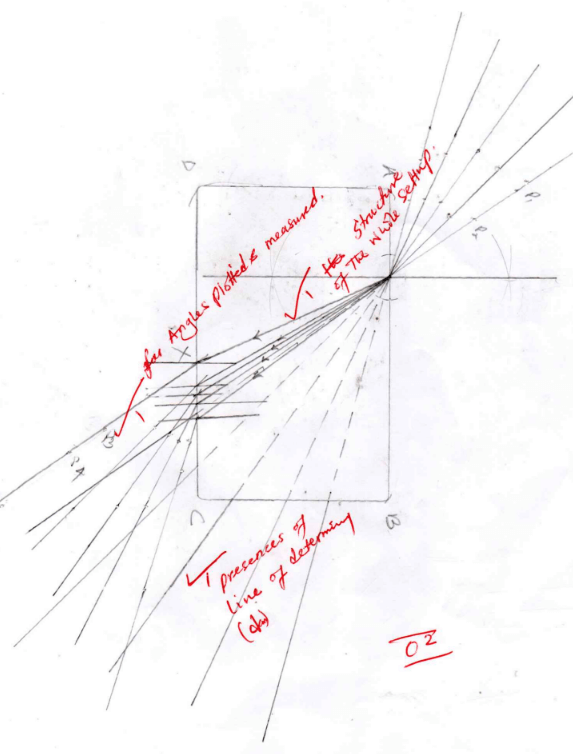
i)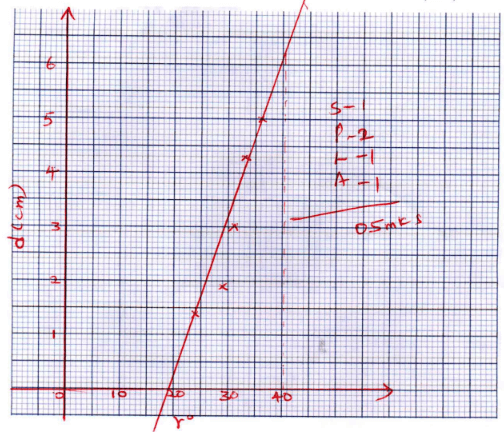
j) (i) r° = 40°
(ii) k sin r° = 1
k sin 40 = 1
k = 1
sin 40
= 1.5557
QUESTION 2
PART A
(a) Boiling point of water = 373 Kelvin (1 mark)
(b) Find the following measurements using appropriate instruments
Mass of the metal solid Ms= 100 g (1/2 mark)
Mass of the wrapped empty plastic beaker
M1 = 31.4g (1 mark)
Use the plastic beaker to measure 240m1 of liquid L, ence find the joint mass of the plastic beaker and its content liquid L,
M2 = 276.1g
Initial temperature of liquid L, T, = 297 Kelvin (I mark)
(c) At boiling point of water, quickly transfer the metal solid into liquid L, stir well and measure the temperature of the mixture i ediately.
Temperature of the mixture
T2 = 304 Kelvin ( I mark)
(d) By using the measurements taken in parts (a), (b) and (c) as well as the equation provided below, determine the specific heat capacity of liquid L.
(Take S.H.0 of metal solid = 480Jkg-1k−1 and S.H.0 of plastic = 359 Jkg-1−1(1)
(Heat lost by metal solid) = (heat gained by liquid L) + (heat gained by plastic beaker) (3 marks)
MsCsΔθs = MLCLΔθL + MpCpΔθp
100 × 480Jkg-1k−1 × (100 − 31) = 244.7kg × CL × (31− 24)
1000 1000
+ 31.4kg × 359 Jkg-1−1 × (31 − 24)
1000
33.2 = 1.7129CL + 7.89082
1.729CL = 3312 − 78.9082
CL = 3233.0918
1.729
= 1869.92Jkg-1k−1
PART B
a)Measure the length, L, of the nic ome wire provided
L = 50.0 cm
b) β = 0.5cm
d) N = 7 turns
e) h1 = 15.0cm
f) h2 = 200cm
g) Determine the spring constant K in S.I units. (1 mark)
F = Ke
K = F/E = mg/e = 20 × 10‾³ × 10N/kg
(20−15) × 10−2m
= 4 N/m
h) Obtain the constant, p, for the wire from the expression: (211i-an
P = 4mgR³
Kr4
= 4 × 20 × 10‾³ × 10 × 1.4691842 × 10−6
4 × 1.6702 × 10−16
= 1.75929 × 109
Where: m is the mass used, g is acceleration due to gravity ( g = 10m/s2 ),
R = L and r = β
2πN 2πN
R = 50 × 10‾² r = 0.5 × 10‾²
2π7 2π7
= 0.0113682 = 0.0001136821
R³ = 1.4691482 × 106 r4 = 1.6702 × 10−16
PART C
Procedure I
a) Read and record the voltmeter V1 and ammeter A1 readings.
V1 = 3.1V
b) Read and record the voltmeter and ammeter re ings. Note the brightness of the bulb.
V2 = 2.8V
A1 = 0.20A
Procedure 2
c) Read and record the voltmeter reading V3
V3 = 1.5V
• Put on the switch. Take note of the brightness of the bulb
d) Read and record the voltmeter and ammeter readings
V4 = 1.4V
A2 = 0.10A
e) Compare the values of V1 and V3
V3 is half of V1
f) Make a conclusion on (e) above
The e.m.f of the two cells in series is 3.0V while the e.m.f of two cells in parallel is 1.5V
g) In which set up does the bulb light for a longer time? Explain in terms of A1 and A2 (1 mark)
In set up two only 0.1A is drawn buy the bulb while in set up one 0.20A is drawn by the bulb.
Download Physics Paper 3 Questions and Answers - Bondo Mocks 2021 Exams.
Tap Here to Download for 50/-
Get on WhatsApp for 50/-
Why download?
- ✔ To read offline at any time.
- ✔ To Print at your convenience
- ✔ Share Easily with Friends / Students

